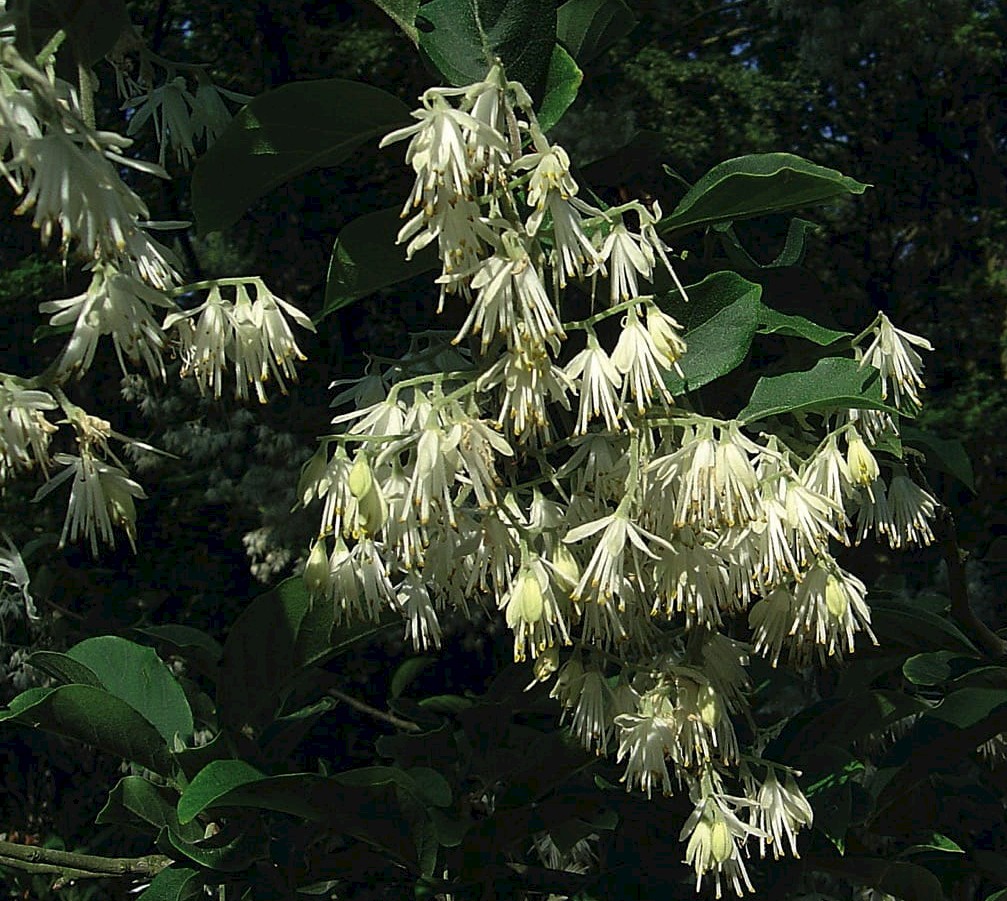Pterostyrax corymbosus
Sponsor
Kindly sponsored by
Arabella Lennox-Boyd
Credits
John Grimshaw & Ross Bayton (2009)
Recommended citation
Grimshaw, J. & Bayton, R. (2009), 'Pterostyrax corymbosus' from the website Trees and Shrubs Online (treesandshrubsonline.
Genus
Common Names
- Little Epaulette-tree
Tree to 15 m, 0.45 m dbh. Bark brown, smooth with pale striations. Branchlets initially covered in stellate tomentum, soon almost glabrous. Leaves papery, 6–14 × 3.5–8 cm, elliptic to obovate, upper surface largely glabrous, lower surface densely covered with stellate tomentum, seven to nine secondary veins on each side of the midrib, margins minutely serrate to glandular-dentate, apex acute to acuminate; petiole 1–2 cm long. Inflorescences paniculate, 3–8 cm long; pedicels 0.1–0.2 cm long. Flowers ~1 cm long; calyx ribbed, densely pubescent, corolla lobes oblong, ~1 cm long, stamens longer than corolla, filaments pubescent. Drupe obovoid, 1.2–2.2 cm long, five-winged, densely tomentose. Flowering March to April, fruiting May to September (China). (Hwang & Grimes 1996).
Distribution China northern Fujian, northern Guangdong, Hunan, Jiangsu, Jiangxi, northwest Zhejiang Japan western Honshu, Kyushu, Shikoku
Habitat Along forest streams, between 400 and 1600 m asl.
USDA Hardiness Zone 5-6
RHS Hardiness Rating H5
Conservation status Not evaluated (NE)
Taxonomic note This species was described briefly by Bean (Bean 1976), who noted that many specimens cultivated under this name are actually P. hispidus – the most significant difference being that the fruits of P. hispidus are five-ribbed, not five-winged, although the inflorescences of P. corymbosus are also usually shorter than the 10–22.5 cm expected in P. hispidus.
According to Jacobson (1996), Pterostyrax corymbosus was introduced to cultivation in 1850 and was commercially available in the United States by 1887; Clarke (1988) records that trees were received at the Washington Park Arboretum in 1957, so it is clear that plants under this name have been in (limited) circulation for quite a long time. It is always difficult to give accurate comments on a species when its identity in cultivation is known to be muddled. Trees labelled as P. corymbosus are grown successfully across our area, and many probably are correctly identified, but it would be useful if their identification could be confirmed. A further case of misidentification has led to this species being propagated in the Netherlands in place of Melliodendron xylocarpum (see New Trees p. 520). One such specimen planted at Arboretum Trompenburg in 1998 has done particularly well, and first flowered and fruited in 2002. When seen in 2005 it was 6–7 m tall and growing vigorously, forming a neat, attractive small tree, with pale green fruits dangling below the branches. Pterostyrax corymbosus is also a great success at Arboretum Wespelaar and Herkenrode (K. Camelbeke, pers. comm. 2007), and thrives at Kew, where several individuals are cultivated, grown from seed collected on Shikoku in 1999 (SOKU 28). The parent trees were found in dense shade in damp forest of the Odamiyama Gorge at 730 m (Townsend & Bridger field notes, Kew database). Dense shade would certainly not be advised in cultivation, where a position in full sun or under light high shade would be more appropriate, depending on the temperature expected in summer. It thrives in semi-shade between the tall conifers in the David C. Lam Asian Garden in Vancouver, however, forming a neat tree of up to 7 m, and flowering profusely (P. Wharton, pers. comm. 2008). As might be expected it flourishes on the East Coast of the United States, including one multistemmed tree of 12 m, seen in the US National Arboretum in 2006. The 1957 trees at Washington Park Arboretum are currently 10–13 m tall, and clearly flourish in the Seattle climate (but their identity has not been confirmed: R. Hitchin, pers. comm. 2008). A little further south, Sean Hogan (pers. comm. 2007) reports that it does well in the drier conditions of Portland, with the aid of small amounts of supplementary water.

